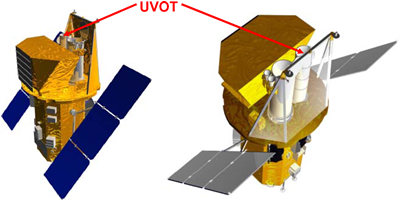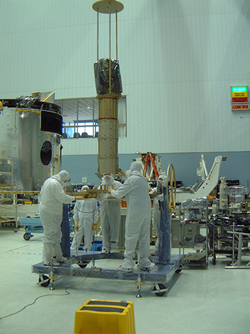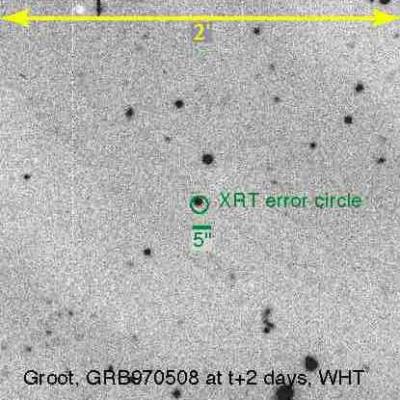
The Ultra-violet Optical Telescope (UVOT)
 The UVOT makes Swift a complete multi-wavelength facility. Co-aligned with the XRT, UVOT provides simultaneous ultraviolet and optical coverage (170-650 nm) in a 17' x 17' field. Despite its limited aperture, UVOT is a powerful complement to other instruments because of its UV capabilities and the absence of atmospheric extinction, diffraction, and background. Since UVOT has photon counting detectors, which are able to retain individual photon positions and timing information, it operates in a mode more similar to typical x-ray telescopes than to typical optical telescopes.
The UVOT makes Swift a complete multi-wavelength facility. Co-aligned with the XRT, UVOT provides simultaneous ultraviolet and optical coverage (170-650 nm) in a 17' x 17' field. Despite its limited aperture, UVOT is a powerful complement to other instruments because of its UV capabilities and the absence of atmospheric extinction, diffraction, and background. Since UVOT has photon counting detectors, which are able to retain individual photon positions and timing information, it operates in a mode more similar to typical x-ray telescopes than to typical optical telescopes.
 The UVOT is a 30 cm modified Ritchey-Chretien UV/optical telescope CO-aligned with the X-ray Telescope and mounted on the telescope platform common to all instruments. An 11-position filter wheel allows low-resolution grism spectra of bright GRBs, magnification, and broad-band UV/visible photometry. Photons register on a microchannel plate intensified CCD (MIC).
The UVOT is a 30 cm modified Ritchey-Chretien UV/optical telescope CO-aligned with the X-ray Telescope and mounted on the telescope platform common to all instruments. An 11-position filter wheel allows low-resolution grism spectra of bright GRBs, magnification, and broad-band UV/visible photometry. Photons register on a microchannel plate intensified CCD (MIC).
The UVOT boasts a strong heritage, in the team's expertise as well as instrument's design, testing, and performance, from the Optical Monitor (OM) on the European Space Agency's X-ray Multi-Mirror Mission (XMM). This heritage has been enhanced by operations of
 XMMOM, which will continue throughout Swift's Operation Phase. To minimize risk, UVOT deviated from the OM hardware design only when forced to by new interfaces to the spacecraft and by the unavailability of OM parts.
XMMOM, which will continue throughout Swift's Operation Phase. To minimize risk, UVOT deviated from the OM hardware design only when forced to by new interfaces to the spacecraft and by the unavailability of OM parts.
UVOT Rationale
Ground observations of GRBs have shown that optical afterglows typically decline in brightness as t-1.1 to t-2.1. Therefore, rapid response is required to observe these counterparts and determine their redshift while they are still bright.
The UVOT is uniquely capable for afterglow studies. It has UV capability which is not possible from the ground. It cannot be clouded out. It is also much more sensitive than any other quick reaction telescope. The UVOT also enables optimal ground based observations by providing rapid optical images of the GRB field so that any optical or IR counterpart can be quickly identified and studied. Stars in the FOV of the UVOT provide an astrometric grid for the GRB field.
UVOT GRB Observations
The UltraViolet and Optical Telescope (UVOT) is a diffraction-limited 30 cm (12"
 aperture) Ritchey-Chretien reflector, sensitive to magnitude 24 in a 17 minute exposure.
Immediately after a GRB is detected and located by the BAT, the spacecraft slews to point both the UVOT and the XRT at the GRB location. The spacecraft's 20-70 second time-to-target means that about ~ 100 GRBs per year (about 1/3 of the total) will be observed by the narrow field instruments during the gamma ray emission. As of the end of January, 1999, only one GRB has been successfully detected optically during the burst-GRB990123 which reached magnitude 9.
aperture) Ritchey-Chretien reflector, sensitive to magnitude 24 in a 17 minute exposure.
Immediately after a GRB is detected and located by the BAT, the spacecraft slews to point both the UVOT and the XRT at the GRB location. The spacecraft's 20-70 second time-to-target means that about ~ 100 GRBs per year (about 1/3 of the total) will be observed by the narrow field instruments during the gamma ray emission. As of the end of January, 1999, only one GRB has been successfully detected optically during the burst-GRB990123 which reached magnitude 9.
When a new GRB is acquired by the spacecraft, the UVOT goes through a predetermined program of exposure times and filter combinations. The initial images are immediately sent to the ground for use as a finding chart by ground-based observers, and for comparison to archival observations of the same patch of sky to detect a variable source that could be the optical counterpart. The filtered observations give the temporal behavior as a function of wavelength. If the GRB is at a distance greater than z ~ 1, the filtered observations allow measurement of the redshift of the GRB.
Here is an optical image of a GRB afterglow, two days after the burst. This observation was made using a large ground-based telescope (the 4.2 meter William Herschel Telescope, observation by Paul Groot) when it was around magnitude 20. This image is cropped to 2 arcminutes (compared to 17 arcmin for the UVOT FOV). The size of the 5 arcsecond diameter position determination from the XRT is shown as a green circle. The UVOT is able to determine the location of any afterglow it sees to an accuracy of a few tenths of an arcsecond.
Swift Mission Operations Center
The Pennsylvania State University301 Science Park Road,
Building 2 Suite 332,
State College, PA 16801
USA
☎ +1 (814) 865-6834
📧 swiftods@swift.psu.edu
Swift MOC Team Leads
Mission Director: John NousekScience Operations: Jamie Kennea
Flight Operations: Mark Hilliard
UVOT: Michael Siegel
XRT: Jamie Kennea
Swift Partners
UK: UCL MSSL Univ. of LeicesterUSA: NASA/GSFC LANL Omitron SwRI
Italy: SSDC/ASI INAF OA-Brera